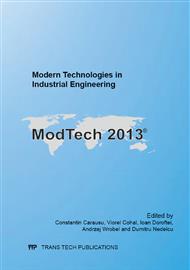p.322
p.328
p.334
p.340
p.346
p.351
p.357
p.363
p.369
Use of Finite Element Method in Optimization of Quay Crane's Grab
Abstract:
This Finite element method is one of the most advanced calculating methods for approximation of accurate solutions to engineering problems. Optimization of grabs quay cranes is necessary because most port operators use this type of equipment for loading and unloading bulk cargo. Initial research methods applied in this study are based on observations and surveys conducted on Bocşa 16 t - 32 m mobile quay cranes of MinMetal S.A. Constanta port operator. Modeling and analysis for grabs structure optimization was made with FEMAP and NX NASTRAN - version 10.3.1 applications, which use the finite element method and finite element analysis. After calculations and analysis, the following optimizations resulted:-to increase the grabs closing force (in order to minimize the loss of cargo between jaws and to increase digging force) the lower beam weight must be reduced.-to reduce the amount of cargo drained from the grabs jaws at loading, rubber jaws barriers can be fixed or bars can be welded at grabs jaws.- if cargo has high granulation, in order to reduce grabs weight the plate of the jaw can be cropped.-cups supporting tie rods could be replaced by hydraulic cylinders.The greatest tension is located in the cups supportive arms and in the area where cups are attached to arms. Shafts tensions are larger than the grabs metal structure and are located in shafts-arms contact areas, ie support bearings. In these areas, an optimization can be made by installing ball bearings to reduce friction. The largest deformations occur in the middle area of the arms. To increase safety in operation it is necessary to change the material of the four arms supporting cups, given that deformation of 89.7 mm (~ 9 cm) combined with external factors and / or shock loads can lead to permanent deformation or even material breaks. After changing the material, the model showed that the deformations in the middle area of the arms are substantially reduced, at only 4 mm. In the contact area of the upper arms with the two bars of the upper beam, hazardous tensions may be minimized if there are inserted bearings.
Info:
Periodical:
Pages:
346-350
Citation:
Online since:
November 2013
Authors:
Keywords:
Price:
Сopyright:
© 2014 Trans Tech Publications Ltd. All Rights Reserved
Share:
Citation:


